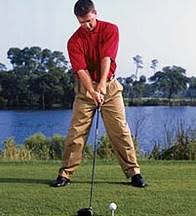No, I don’t mean that you should beat-up on yourself. Every time you play a round of golf you should be using your strengths to improve your game. Why not play a game against your current handicap or an average score that you would like to beat. Or you may plan to shoot a round under 100 or 90 or 80. The best way to succeed is set a realistic score for each hole that you are about to play based on the handicap level for each of the 18 holes.
You will never improve your game if you keep taking the same approach to every hole.
Every hole on every golf course is rated from 1 to 18 based on the hardest hole being the #1 handicap hole and 18 being the easiest. Before you start a round of golf decide on the number of strokes that you will allow yourself over par and mark your card on each of the lower handicap holes (difficult holes) to play those holes as a bogie or double bogie hole.

Stay in the Right Frame of Mind
1/ Take the pressure off your mind and relax the swing with each club. You will be amazing at how easy it is to hit every shot to 80% of your expected distance with your chosen club.
2/ You will lower your scores if you take the pressure off your game by playing shots to a safe area at the front of the green and then chipping for a 1 or 2 putt green.
3/ Use a club with less loft so that you can back-off on the power that you are attempting to hit. This will improve the consistency of your shots.
4/ Be realistic about your ability to hit each club exactly with your best hit in the center of your club face. Typically 80% of your shots will not reach the distance that you expect.
5/ Driver is the only club that you want to hit with more power for more distance (to shorten every hole). Don’t get carried away! Know your setup and swing that will give you the most power with draws or fades using your driver. Know your ability and stick with a controlled swing.
Learn to be a strategic golfer BY AVOIDING KILL SHOTS. Choosing more club with less power will help you keep more shots in the fairway. They call your other option in the ROUGH because it’s not where you want to be.
Remember to play YOUR game against YOUR ability without trying to kill the ball. Take more time to rotate your hips as you start your backswing and add lag by cocking your wrists to generate more power. GOLFSTR+ is designed to remind you to keep your leading arm straight and to limit your backswing. Buy one today at www.GOLFSTR.com











